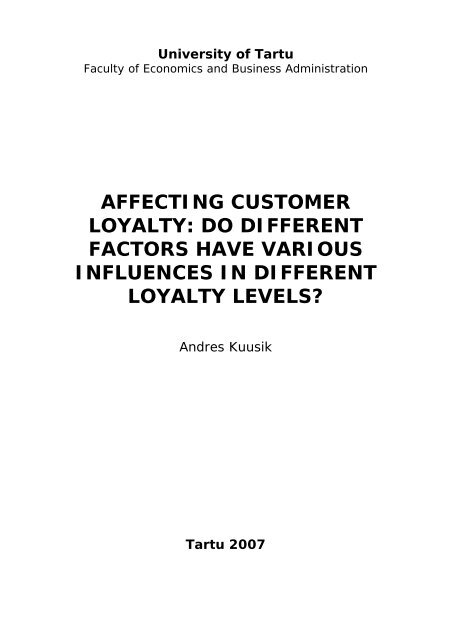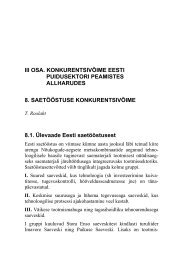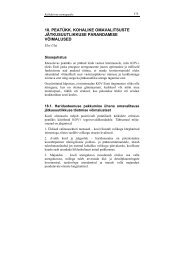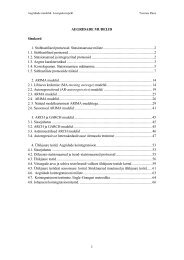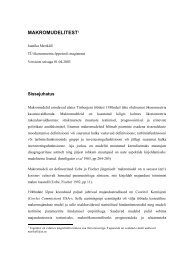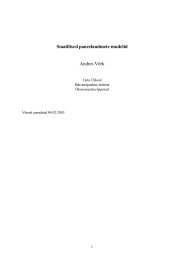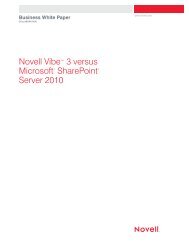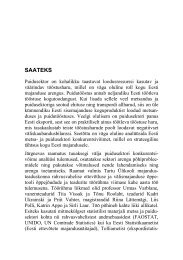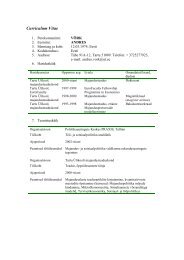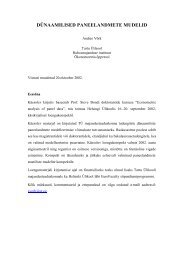AFFECTING CUSTOMER LOYALTY: DO DIFFERENT FACTORS ...
AFFECTING CUSTOMER LOYALTY: DO DIFFERENT FACTORS ...
AFFECTING CUSTOMER LOYALTY: DO DIFFERENT FACTORS ...
You also want an ePaper? Increase the reach of your titles
YUMPU automatically turns print PDFs into web optimized ePapers that Google loves.
University of TartuFaculty of Economics and Business Administration<strong>AFFECTING</strong> <strong>CUSTOMER</strong><strong>LOYALTY</strong>: <strong>DO</strong> <strong>DIFFERENT</strong><strong>FACTORS</strong> HAVE VARIOUSINFLUENCES IN <strong>DIFFERENT</strong><strong>LOYALTY</strong> LEVELS?Andres KuusikTartu 2007
2Andres KuusikISSN 1406–5967ISBN 978–9949–11–735–2Tartu University Presswww.tyk.eeOrder No. 366
Affecting customer loyalty 3Affecting customer loyalty:do different factors have variousinfluences in different loyalty levels?Andres Kuusik 1AbstractThe current paper studies the influence of various factors oncustomer loyalty. The main hypothesis of the study insists that thelist of most important factors affecting loyalty is dependant on thelevel of loyalty of costumers. LOGIT method was used for testingthe hypotheses on the sample of survey data about 1000 privatecustomers of the biggest telecommunication company in Estonia.The results reveal that four analysed factors affecting customerloyalty (satisfaction, trustworthiness, image and importance ofrelationship) are playing different role on the different levels ofcustomer loyalty.1University of Tartu, Faculty of Economics and Business Administration,PhD Student, MA (Econ.), Narva Rd. 4–A214, Tartu 51009,Estonia, e-mail: Andres.Kuusik@ut.ee
Affecting customer loyalty 5• Find the key factors that have impact on loyalty;• Set up hypotheses and create relevant model for theloyalty in the telecommunication company;• Analyse the model and test the hypotheses.The first section of the paper presents an overview about theprevious research on customer loyalty. The second section isdevoted to the construction of a theoretical model, followed by thedescription of the research object and methods. The last sectionpresents the results and provides the discussion. The impact of thevarious factors on loyalty is explored by the example of firmElion – the leading telecommunication provider in Estonia. Thedata used for the analysis originate from Elion Customer SatisfactionSurvey carried out in November 2003. The survey containsinformation about 1000 private customers. LOGIT method is usedfor testing the hypotheses. Software packages MS Excel 2000 andStata 9.2 have been used for data processing.LITERATURE OVERVIEWSegmentation based on customer loyaltyThere are multiple approaches to customer loyalty. Theories ofbehavioral loyalty were dominating until 1970 considering loyaltyas the function of the share of total purchases (Cunningham1956:118; Farley 1964:9), function of buying frequency or buyingpattern (Tucker 1964: 32; Sheth 1968: 398) or function of buyingprobability (Harary et al. 1962; McConnell 1968:14; Wernerfelt1991: 231). These approaches looked at brand loyalty in terms ofoutcomes (repeat purchase behavior) rather than reasons, until Day(1969) introduced the two-dimensional concept of brand loyalty,which stated that loyalty should be evaluated with both behavioraland attitudinal criteria. Contemporary researches consider andaccent the psychological (mostly attitudinal and emotional) factorof loyalty (Jacoby et al. 1973:2; Oliver 1999: 34; Chaudury 1995:28; Djupe 2000: 79; Reichheld 2003: 47). There are also
6Andres Kuusikapproaches comparing loyalty with marriage (Hofmeyr et al. 2000:53–83; Lewitt 1983: 89; Dwyer et al. 1987: 14).These different approaches allow distinguishing customers aswhether behaviorally or emotionally loyal. Behaviorally loyalcustomers act loyal but have no emotional bond with the brand orthe supplier whereas emotionally loyal customers do. Jones andSasser call these two kind of loyalty accordingly false or true longtermloyalty (Jones et al. 1995: 90). Hofmeyr and Rice (2000: 87)divide customers to loyal (behavioral) or committed (emotional).Emotional loyalty is much stronger and longer lasting than behavioralloyalty. It’s an enduring desire to maintain a valued relationship.The relationship is so important for the customer that he orshe makes maximum efforts to maintain it. (Morgan et al. 1995:24; Reichheld 2003: 9; Moorman et al. 1992: 316) Highly bondedcustomers will buy repeatedly from a provider to which they arebonded, recommend that provider to others, and strongly defendthese choices to others – insisting that they have chosen the “best”product or service. (Butz et al. 1996: 65)Behaviorally loyal customers could be divided to sub-segments bythe reason of acting:• Forced to be loyal,• Loyal due to inertia or• Functionally loyal.Customers are forced to be loyal when they have to be clients evenif they do not want to. Customers may be forced to consumecertain products or products/services offered by certain vendor e.g.when the company acts as a monopoly or the poor financial statusof the customer is limiting his selection of goods. Grönholdt,Martensen and Kristensen have found that companies with lowprice strategy had a much higher loyalty than expected from theircustomer satisfaction. On the other hand, companies that had useda lot of energy on branding indeed had a high customer satisfactionbut they did not have a correspondingly high loyalty. (Grönholdt etal. 2000: 512) Forced loyalty could be established trough creatingexit barriers as well.
Affecting customer loyalty 7Loyal behaviour may also result from inertia – customer does notmove to another vendor due to comfort or relatively low importanceof operation – if the choice has low importance, there is nopoint to spend time and effort on searching for alternatives. Thus,based on his faith in the suitability of the current product, thecustomer continues to use it without checking alternatives. It’s inaccordance to Oliver’s approach of cognitive loyalty: the loyaltythat is based on brand belief only. “Cognition can be based onprior or vicarious knowledge or on recent experience-based information.If the transaction is routine, so that satisfaction is notprocessed (e.g. trash pickup, utility provision), the depth of loyaltyis no deeper than mere performance.” (Oliver 1999: 35) Hofmeyrand Rice (2000: 23) say that one of the reasons that customersdon’t switch brands when they are dissatisfied is that they feel thatthe alternatives are just as bad as the brand they are using or evenworse. Inertia may be caused also by lack of information aboutattractive characteristics of the brands (Wernerfelt 1991:231).Functionally loyal customers are loyal because they have anobjective reason to be. Wernerfelt points out “cost-based brandloyalty” where brand utilities have a positive influence on brandchoice. (Wernerfelt 1991:231) Functional loyalty can be created byfunctional values using price, quality, distribution, usage convenienceof a product or through different loyalty programs (points,coupons, games, draws etc.) giving a concrete reason to prefercertain supplier. Unfortunately competitors can most easily copyfunctional values. Thus, creating functional value offers a fleetingcompetitive advantage: functional loyalty can’t be very longlasting. (Barnes 2003: 8)Jones and Sasser (1995:94) propose three measures of loyalty thatcould be used in segmentation by loyalty:• Customer’s primary behavior – recency, frequency andamount of purchase;• Customer’s secondary behavior – customer referrals,endorsements and spreading the word;• Customer’s intent to repurchase – is the customer readyto repurchase in the future.
8Andres KuusikBased on the theoretical literature presented above, the customersof a certain telecommunication provider could be segmented bytheir loyalty as follows (see also Figure 1):CustomersLoyalDisloyalDubiousCommittedBehaviorallyloyalReducersLeaversFigure 1. General segmentation of customers by loyalty• Committed or emotionally loyal customers – activecustomers who use only the certain provider’s servicesand declare that they will use only this provider in thefuture and recommend this provider to others;• Behaviorally loyal customers – active customers whouse only the certain provider’s services and declare thatthey will use only this provider in the future but do notagree to recommend this provider to others (inert orfunctionally loyal);• Ambivalent or dubious customers – active customerswho use only the certain provider’s services but don’tknow which provider they will use in the future;• Disloyal reducers– customers who have reduced or willreduce the percentage of the provider’s services in theirusage;• Leavers – customers who declare, that they will certainlyleave this provider.
10Andres KuusikTidwell and Horgan (1993: 349) have showed that people useproducts to enhance self-image.Secondly, according to social identity theory, people tend to classifythemselves into different social categories. That leads to evaluationof objectives and values in various groups and organisations in comparisonwith the customer’s own values and objectives. They preferpartners who share similar objectives and values. (Ashforth et al.2001: 23) Fournier (1998: 366) states that consumer-brand relationshipsare more a matter of perceived goal compatibility. Brandscohere into systems that consumers create not only to aid living butalso to give meanings to their lives. Oliver (1999: 40) argues that forfully bonded loyalty the consumable must be part of the consumer’sself-identity and his or her social-identity.Trustworthiness of the partner is a factor that has certain impact onthe establishment of loyalty – nobody expects a long-term relationwith a partner that cannot be trusted. Trustworthiness is one criterionfor measuring the value of the partner. (Doney et al. 1997: 46)Spekman (1988: 79) calls trust a cornerstone of the strategicpartnership. Morgan and Hunt (1994: 22) posit that trust is a majordeterminant of relationship commitment: brand trust leads to brandloyalty because trust creates exchange relationships that are highlyvalued. Chauduri and Holbrook (2001: 91) have showed that brandtrust is directly related to both purchase and attitudinal loyalty.Many authors have accented that trust is important in conditions ofuncertainty (Moorman et al. 1992: 315; Doney et al. 1997: 36;Dwyer et al. 1987: 12–13; Morgan et al. 1994: 23). Uncertaintymay be caused by dependence or large choice: people tend then toprefer popular or familiar brands or partners.Many definitions describe loyalty as a desire to retain a valuable orimportant relationship. (Morgan et al 1994: 22; Moorman et al.1992: 316) That way the establishment of loyalty is predeterminedby the importance of relevant relationship or selection. Weiss(2001) points out three aspects that may increase the importance ofthe relationship:• Strategic importance of a product,• High risks involved in the transaction or• Costs incurred by cancellation of contracts.
Affecting customer loyalty 11Hofmeyr and Rice point out that the more important the relationshipis to a person, the more willing that person is to tolerate dissatisfactionin favour of trying to fix it. By contrast, when a relationshipdoesn’t matter, then even the perfectly satisfied consumer canswitch on a whim. (Hofmeyr et al. 2000: 60)A relationship can also be made important by personal approach.Various authors have compared loyalty with marriage (Levitt1983; Dwyer et al. 1987; Gummeson 1998; Hofmeyr et al. 2000).Marriage is one of the most personal and important relationships.That means that intimacy is one determinant for importance ofrelationship. Levitt (1983: 89) has considered a role of salesman inmaking relationship more personal.Summarising the discussion above following figure 2 is presentingthe major groups of factors affecting customer loyalty.Satisfactionwith productsSatisfactionExpectationsSupplierTrustworthinesProductSalesmanSatisfactionwith serviceLoyaltyOther factorsBrandpersonalityImageGoals and valuesof supplierImportance ofrelationshipImportance ofthe productTerminationcostsIntimacy ofrelationshipFigure 2. Factors affecting loyalty.Other factors not shown on Figure 2 are for example price, priceactivity, distribution, existence or domination of alternatives(Farley 1964: 9–10); social class, demographic characteristics andother individual and environmental factors (Kanwar et al. 1992:589); advertising pressure, constraints on choice (budgetlimitations, time pressures), usage situation (Lattin 1987: 48);double jeopardy phenomenon (Ehrenberg et al. 1990:82) etc.
14Andres KuusikEvery factor listed above was divided into 3 to 7 subcategories(e.g. accounting had subcategories like the accuracy and understandabilityof bills, dept management, availability of differentpayment methods). Satisfaction with the factors reveals from thesatisfaction with those subcategories. Additionally customersanswered about their general satisfaction with the firm Elion. Thesatisfaction was also measured on a 5-point scale, where “1” is“not satisfied at all” and “5” is “very satisfied”.Customer loyalty was measured by following questions:• What operators are the customers using right now?• What operators will the customers use in 2 years?• Does the customer recommend or is the customer ready torecommend Elion to others?In the current analysis only the raw data of mentioned survey isused. Software packages MS Excel 2000 and Stata 9.2 have beenused for data processing.ModelA LOGIT model for testing Hypothesis 1 is presented below:L(12) i = 1/(1+e -Z )L(13) i = 1/(1+e -Z )L(14) i = 1/(1+e -Z )L(15) i = 1/(1+e -Z )L(23) i = 1/(1+e -Z ) (1)L(24) i = 1/(1+e -Z )L(25) i = 1/(1+e -Z )L(34) i = 1/(1+e -Z )L(35) i = 1/(1+e -Z )L(45) i = 1/(1+e -Z )Where Z= β1 +β2SATi + β3IMi + β4TRSTi + β5IMPi ++ β6FT1i + β7FT2i + β8FT3i + β9PP1i+ β10PP2)+u iand L(12) i = 0 if customer is leaver and 1 if customer is reducer;L(13) i = 0 if customer is leaver and 1 if customer is dubious;L(14) i = 0 if customer is leaver and 1 if customer is slightlyloyal;
Affecting customer loyalty 15L(15) i = 0 if customer is leaver and 1 if customer isemotionally committed;L(23) i = 0 if customer is reducer and 1 if customer is dubious;L(24) i = 0 if customer is reducer and 1 if customer is slightlyloyal;L(25) i = 0 if customer is reducer and 1 if customer isemotionally committed;L(34) i = 0 if customer is dubious and 1 if customer is slightlyloyal;L(35) i = 0 if customer is dubious and 1 if customer isemotionally committed;L(45) i = 0 if customer is slightly loyal and 1 if customer isemotionally committed;SATi is satisfaction;IMi is image;TRSTi is trustworthiness;IMPi is importance of relationFT1 i = 1, if it is a “family with children” and 0, if any otherfamily type;FT2 i = 1, if it is a “small family without children” and 0, ifany other family type;FT3 i = 1, If it is “senior’s family” and 0, if any other familytype.FT1 i = FT2 i = FT3 i =0, it is not “standard family” for Elion.PP1 i = 1, if it is a “family with medium income” and 0 in anyother;PP2 i = 1, if it is a “family with high income” and 0 in anyother.PP1 i = PP2 i = 0, it is a “family with low income”.In Model 1, regression coefficients show the direction of change ofthe probability that dependent variable L(ab) i will receive the value“1”, when the independent variable changes. LOGIT equation isnonlinear in β’s ; therefore these coefficients do not show exactlyhow much the probability will change. For the measurement of theexact prognosis the marginal effects should be calculated (in thecontext of the present paper the prognosis is not important).With the help of Model 1 it is possible to observe the movement ofcustomers from one loyalty level into any other level. Moving
16Andres Kuusikfrom leavers level into emotionally committed level (described asL(15)) is very unlikely but the opposite movement is not excepted.The movements described in figure 3, are marked in bold in model1 – L(12); L(23); L(34); L(45).SAT i in Model 1 is a complex variable, aggregating many differenttypes of satisfaction: overall satisfaction, satisfaction with products,service quality and prices. SAT i is weighted average of customers’opinions about mentioned satisfaction types:SAT i = k 1i * SAT(overall) i + k 2i * SAT(service) i+ k 3i * SAT(products) i + k 4i * SAT(price) i(2)Where k ji = T ji / Σ(T 1i ;…;T 4i ) andT ji is importance assigned by customers to different factors using a5-point scale where 1= “is not important at all” and 5 = “is veryimportant”. These values were later modified. New values of T jiare: 1 = 0; 2 = 0.25; 3 = 0.5; 4 = 0.75; 5 = 1.Importance of overall satisfaction was not asked. Therefore it isassigned T 1i = 1 for weighting. For example, if the customeranswered that importance of service quality in a 5-point scale is“4”, importance of product’s quality is “3” and importance of priceis “5”, then corresponding T and k values are as follows:SAT(overall): T 1 = 1 k 1 = 1 / 3.25 = 0.31SAT(service): T 2 = 0.75 k 2 = 0.75 / 3.25 = 0.23SAT(products): T 3 = 0.5 k 3 = 0.5 / 3.25 = 0.15SAT(price): T 4 = 1 k 4 = 1 / 3.25 = 0.31Σ(T 1 ;…;T 4 ) = 3.25 Σ(k 1 ;…;k 4 ) = 1Different satisfaction variables in equation (2) are measured by 4–10questions (except SAT(overall)). Customers answered on 5-pointscale, where 1= “not satisfied at all” and 5= “very satisfied”. SAT(service) is measured by 6 questions about service quality, 2 questionsabout complaints management and 2 questions about offeringstyle of various products. SAT(products) is measured by 7 questionsabout assortment, quality and contemporariness of products. SAT(price) is measured by 4 questions about price level and discounts.
18Andres KuusikRESULTS AND DISCUSSIONAs shown in Table 1 of Appendix 1, all equations in Model 1 weresignificant at confidence level α=0.05. There is also number ofobservations for each equation in the last column of the table.Significant factors at confidence level α=0.05 of different equationsare shown in Table 1. The results indicate that there is strongevidence to support both Hypotheses 1 and 2. It is clearly seen thatthe influence of each particular factor is significant at least in onelevel of loyalty. It is also seen that different factors are significantin different equations.Table 1. Results of LOGIT analysis*Equation Factor Coefficient Z pL(12) i SAT 1.71 4.04 0.00IMP 0.18 2.04 0.04L(13) i SAT 1.41 3.03 0.00IMP 0.33 2.71 0.01L(14) i SAT 1.59 3.35 0.00IMP 0.25 2.29 0.02L(15) i SAT 2.57 4.27 0.00IMP 0.30 2.4 0.02L(23) iL(24) iL(25) iL(34) i IM -0.45 -1.96 0.05TRST 0.77 2.31 0.02L(35) i TRST 0.92 2.43 0.02L(45) i SAT 0.82 2.29 0.02IM 0.75 3.36 0.00*Includes only significant results on confidence level α=0.05In equations L(12); L(13); L(14); L(15) and L(45), there aresatisfaction and importance of relationship having a significantinfluence on loyalty. Trustworthiness influences loyalty signifi-
Affecting customer loyalty 19cantly in equations L(34) and L(35). The image is significant onlyin equation L(45).While equations in Model 1 describe the probability to move fromone loyalty segment to another, it’s possible to interpret regressioncoefficients both ways. The positive coefficient for example inequation L(12) shows that growth of a particular factor score willincrease the probability that the leaver will move to disloyalsegment. But it also shows that growth of particular factor scorewill decrease the probability that the disloyal customer moves tosegment of leavers.According to Table 1, it’s possible to say that the importance ofrelationship has a major impact on making the decision toterminate contract with the current vendor – if the relationship isconsidered important, the chances of moving to another vendor areless probable. In this model the “importance of relationship”depended primarily on the number of products used by thecustomer, therefore Elion has to think of providing free of chargeadditional and comfort services in order to increase the loyalty ofpotentially leaving customers.According to the data the behavioural loyalists valued the trustworthinessof Elion. If trustworthiness of the vendor decreases, theprobability that the customer starts to consider alternatives, i.e.becomes doubtful, will increase. In order to turn a behaviourallyloyal customer into an emotional loyalist, one has to ensuremaximum satisfaction of the customer and it is also important tomatch the image and values.The results reveal that there are no factors treated in this modelinfluencing disloyal customers to increase their loyalty orinfluencing loyal or dubious customers shift to disloyal segment.Maybe the disloyal segment is not correctly defined. But it couldalso be the case that the borderline between doubtful and disloyalcustomers is obscure. It is possible that doubtful customers havedeveloped a predisposition to disloyalty and their actual realisationof disloyalty depends on factors that were not covered by themodel established in this present work.
20Andres KuusikIn equation L(34) the image had a negative coefficient which isillogical and does not support the hypothesis 1. The author’sopinion is that there is no problem in the model or dissonance inhypothesis. The reason of this result is hidden partly in the scale,used in the questionnaire and partly in the nature of behaviouralloyalist segment. As said in part 2.2 of this paper, the scale was a5-point scale, where “1” was a negative opinion about image –“not satisfied at all” and “5” was a positive opinion – “very satisfied”.In the middle of this scale is “3” marking a neutral attitude tothe image of Elion. It’s very probable that the customers who donot emphasise who is the vendor and what image it has, willanswer neutrally – they have no positive and no negative feelingswith Elion’s image. They are probably loyal due to inertia. As saidbefore, customers who are loyal due to inertia start to think aboutalternatives when something does not work, i.e. trustworthiness ofthe vendor decreases. Until this point they do not think about theimage of their current vendor. They need to evaluate it when theystart to compare the current vendor with others or they are movingto committed customers segment. The support of this statement ispresented in Appendix 2, where in Table 1 there are the meanscores of factors assessed by different segments and in Table 2 therelative shares of different answers in three loyalty segments aregiven. As Table 1 in Appendix 1 shows, the mean value ofbehavioural loyalists’ evaluation of Elion’s image is statisticallysignificantly lower than the mean values of dubious or committedsegments’ evaluations. Table 2 in Appendix 1 indicates the reason:No other segment has chosen so much the answer “3” in the scalethan the segment of behavioural loyalists (19%, compared withdubious 15% or with committed 6%).
Affecting customer loyalty 21CONCLUSIONThe findings of the present study reveal that it is not accurate totreat all customers equally in terms of methods of increasing theirloyalty. The research supports the research proposition that the listof most important factors affecting loyalty is dependant on thelevel of loyalty of costumers. Figure 4 summarises the findings ofthe study and shows that overall satisfaction and importance ofproducts (or relationship) build the foundation of any kind ofloyalty. It shows also that reliability of products or trustworthinessof the vendor is most critical for behavioural loyalists and theimage creation is the main tool for getting committed customers.ImageTrustworthinessP(45)5. Committed???P(34)4. LoyalImportanceSatisfactionP(12)P(23)2. Reducers3. Dubious1. LeaversImportanceSatisfactionFigure 4. Results of the study: the factors that have statisticallysignificant influence on loyalty on particular loyalty levels.The method for collecting the source data set certain constraints onthe adequacy of the model. Although the quality of the source datawas good (high number and trustworthiness of respondents), thequestionnaire was drawn for measuring customer satisfaction, i.e.for the purposes other than required by this given model. Thereforemany factors were derived indirectly and with certain limitations,and they may lack some qualities considered in the theoretical part.There are multiple ways for further development of the model, butfirst there is need to elaborate reliable questionnaires for colletingthe source data.
22Andres KuusikREFERENCESAaker, J. L. The Malleable Self: The Role of Self-Expression inPersuasion. – Journal of Marketing Research, 1999, Vol. 36, Issue1, pp. 45–58.Andreson, E.W., Fornell, C. Foundations of the American CustomerSatisfaction Index. – Total Quality Management, 2000, Vol. 11,No. 7, pp. 869–882.Ashforth, B. E., Mael, F. Social Identity Theory and the Organization.– Academy of Management Review, 1989, Vol. 14, No. 1,pp. 20–39.Barnes, J. Loyalty: A Multidimensional Concept.(www.CRMguru.com) 2004Belk, R. W. Possessions and the Exended Self. – Journal of Consumerresearch, 1988, Vol. 15, pp.139–168.Butz, H. E. jr., Goodstein, L. D. Measuring customer value: gaininga strategic advantage. – Organiszational dynamics, 1996, Vol. 24,Issue 3 pp. 63–77.Chaudhuri, A. Brand Equity or double jeopardy. – Journal of Product& Brand Management, 1995, Vol. 4, No. 1, pp. 26–32.Chaudhuri, A., Holbrook, M. B. The chain of effects from brandtrust and brand affect to brand perfomance: the role of brandloyalty. – Journal of Marketing, 2001, Vol. 65, Issue 2, pp. 81–94.Cunningham, Ross, M. Brand Loyalty – what, where, how much? –Harward Business Review, 1956, No. 34, pp. 116–128.Day, G. S. Creating a Superior Customer-Relating Capability. – MITSloan Management Preview, 2003, Vol. 44, Issue 3, pp. 77–83.Djupe, P.A. Religious Brand Loyalty and Political Loyalties. – Journalfor the Scientific Study of Religion, 2000, Vol. 39, Issue 1,pp. 78–90.Doney, P. M., Cannon, J. P. An Examination of the Nature of Trustin Buyer-Seller Relationships. – Journal of Marketing, 1997, Vol.61, pp. 35–51.Dwyer, F. R., Schurr, P. H., Oh, S. Developing Buyer-SellerRelationships. – Journal of Marketing, 1987, Vol. 51, pp.11–27.Ehrenberg, A. S. C., Goodhardt, G. J., Barwise, T. P. Double JeopardyRevisited. – Journal of marketing, 1990, Vol. 54, pp. 82–91Farley, John, U. Why Does “Brand Loyalty” Vary Over Products? –Journal of Marketing Research, Nov 1964, pp. 9–14
Affecting customer loyalty 23Fournier, S. Consumers and their Brands: Developing RelationshipTheory in Consumer Research. – Journal of Consumer Research,1998, Vol. 24, pp. 343–373.Grönholdt, L., Martensen, A., Kristensen, K. The relationshipbetween customer satisfaction and loyalty: cross-industry differences.– Total Quality Management, 2000, Vol. 11, Nos. 4/5&6,pp. 509–514.Gummesson, E. Productivity, quality and relationship marketing inservice operations. – International Journal of Contemporary HospitalityManagement, 1998, Vol. 10/1, pp. 4–15.Harary, F.; Lipstein, B. The Dynamics of Brand Loyalty: A MarkovianApproach. – Operations Research, 1962, Vol. 10, Issue 1,pp. 19–40.Heskett, J. L., Jones, T. O., Lovemann, G. W., Sasser, W. E. jr.,Schlesinger, L. A. Putting the Service-Profit Chain to Work. –Harward Business Review, 1994, Vol. 72, Issue 2, pp. 164–174.Hofmeyr, J., Rice, B. Commitment-Led Marketing. Chichester: JohnWiley & Sons Ltd., 2000, 299p.Jacoby, J., Kyner, D. B., Brand Loyalty Vs. Repeat Purchasing Behavior.– Journal of Marketing Research, 1973, Vol. 10, pp. 1–9.Jones, T. O., Sasser, Jr. W. E. Why satisfied Costumers Defect. –Harward Busines Rewiev, 1995, Vol. 73, Issue 6, pp. 88–99.Kanwar, N., Pagiavlas, N. When Are Higher Social Class ConsumersMore and Less Brand loyal Than Lower Social Class Consumers?:The Role of Mediating Variables. – Advances in Consumer Research,1992, Vol. 19, pp. 589–595.Kim, C. K., Han, D., Park, S. The effect of brand personaliy andbrand identification on brand loyalty: Applying the theory of socialidentification. –.Japanese Psychological Research, 2001, Vol. 43,No. 4, pp. 195–206.Lattin, J. M. A Model of Balances Choice Behavior. – MarketingScience, 1987, Vol. 6, No. 1, pp. 48–65Lewitt, T. After the sale is over… – Harward Business Review, Sept./Oct 1983, pp. 87–93.McConnell, D. J. The Development of Brand Loyalty: An ExperimentalStudy. – Journal of Marketing Research, 1968, Vol. 5, pp.13–19.Moorman, C., Zaltman, G., Deshpande, R. Relationships BetweenProviders and Users of Market Research: The Dynamics of TrustWithin and Between Organizations. – Journal of MarketingResearch, 1992, Vol. 29, pp. 314–328.
24Andres KuusikMorgan, R. M., Hunt, S. D. The Commitment – Trust Theory ofRelationship marketing. – Journal of Marketing, 1995, Vol. 58,Issue 3, pp. 20–39.Oliver, R. L. Whence Consumer Loyalty? – Journal of Marketing,1999, Vol. 63, pp. 33–44.Reichheld, F. F. The One Number You Need to Grow. – HarwardBusiness Review, 2003, Vol. 81, Isssue 12, pp. 46–55.Reichheld, F. F. Loyalty-based management. – Harvard BusinessReview, 1993, Vol. 71, Issue 2, pp. 64–72.Reichheld, F. F.; Markey, R. G.; Hopton, C. „The loyalty effect –the realtionship between loyalty and profits”; European BusinessJournal 2000 (p. 134–139)Rosenberg, L., Czepiel, J.A. A Marketing Approach to CustomerRetention. – Journal of Consumer Marketing, 1984, Vol. 1, pp.45–51.Sheth, J. N. A Factor Analytical Model of Brand Loyalty. – Journalof Marketing Research, 1968, Vol. 5, pp. 395–404.Spekman, R. E. Strategic Supplier Selection: Understanding Long-Term Buyer Relationships. – Business Horizons, July–August1988, pp. 75–81.Tidwell, P. M., Horgan, D. D.. Brand character as a function of brandloyalty. – Current Psychology, 1992/93, Vol. 11, Issue 4, pp. 346–353.Tucker, W. T. The Development of Brand Loyalty. – Journal ofMarketing Research, Aug. 1964, pp. 32–35.Weiss, A. When Do B2B Customers Want a Close Relationship?MarketingProfs.com (www.MarketingProfs.com/tutorials) 2001.Wernerfelt, B. Brand Loyalty and Market Equilibrium. – MarcetingScience, 1991, Vol. 10, No. 3, pp. 229–245.
Affecting customer loyalty 25KOKKUVÕTEMõjutades kliendi lojaalsust: kas erinevatel teguritelon erinevatel lojaalsustasemetel erinev mõju?Kliendilojaalsus on viimastel aastatel muutunud väga aktuaalseksteemaks, kuna tänu konkurentsi globaliseerumisele, turgude küllastumisele,infotehnoloogia arengule ja seoses sellega klientide teadlikkusesuurenemisele on tekkinud situatsioon, kus pikaajalist eduei taga enam toote parameetrite ja hinna optimeerimine vaidvõtmepositsioonile on asetunud pikaajaline suhe kliendiga. Uuringudon näidanud, et uue kliendi saamise kulud on olemasolevakliendi säilitamise kuludega võrreldes ca 5 korda suuremad.Vastavalt erinevatele käsitlustele, mis eristavad käitumuslikku jaemotsionaalset lojaalsust, eristati käesolevas töös järgmisi lojaalsuselbaseeruvaid kliendisegmente:Emotsionaalselt lojaalsed – kliendid, kes kasutavad hetkel ainultkindla operaatori teenuseid ja kes lubavad seda ka tulevikus tegema.Samuti on nad nõus kindlasti soovitama seda operaatorit ka teistele.Käitumuslikult lojaalsed – kliendid, kes kasutavad hetkel ainultkindla operaatori teenuseid ja kes lubavad seda ka tulevikus teha.Samas ei ole nad nõus soovitama seda operaatorit teistele (inertseltvõi funktsionaalselt lojaalsed).Kahtlejad – kliendid, kes hetkel kasutavad ainult kindla operaatoriteenuseid, kuid ei tea, mida nad teevad tulevikus.Osakaalu vähendajad – kliendid, kes kasutavad hetkel kindlaoperaatori teenuseid kuid lubavad tulevikus hakata kasutama kateiste operaatorite teenuseid, samuti kliendid, kes juba kasutavadkindla operaatori kõrval teisi pakkujaid.Lahkujad – kliendid, kes lubavad tulevikus loobuda kindla operaatoriteenustest.Nimetatud kliendisegmentide peal uuriti nelja teguri – rahulolu,usaldusväärsuse, suhte olulisuse ja kuvandi – mõju lojaalsusele.Andmed pärinesid Elioni kliendirahulolu uuringust ja andmeteanalüüsiks kasutatud LOGIT meetodit.
26Andres KuusikTulemused näitasid, et erinevatel tasemetel mõjutavad lojaalsusterinevad tegurid. Rahulolu ja suhte olulisus on peamised tegurid,mis tagavad, et klient ei muutuks lahkujaks. Usaldusväärsus onoluline käitumuslikult lojaalsetele klientidele – kuni kõik on korras,ei mõtle nad alternatiividele. Käitumuslikult lojaalsete klientidemuutmisel emotsionaalselt lojaalseks on oluliseks mõjutegurikskuvand. Teatavad piirangud tulemuste tõlgendamisele seab andmetekogumiseks olnud küsimustik. Seetõttu on teema edasiarendamiseksvaja eelkõige luua usaldusväärsed küsimustikud.
Affecting customer loyalty 27Appendix 1Table 1. Overall significance of equations.Equation χ 2 p N of obsL(12) i 42.81 0.00 510L(13) i 33.11 0.00 151L(14) i 36.85 0.00 231L(15) i 63.86 0.00 193L(23) i 36.01 0.00 571L(24) i 58.51 0.00 651L(25) i 74.33 0.00 613L(34) i 19.14 0.02 292L(35) i 34.46 0.00 254L(45) i 35.08 0.00 334Source: Calculations of author.
Appendix 2Table1. The mean values and standard deviations of the independent variables of Model 1 by different loyalty segmentsSatisfaction Image Trust-worthiness ImportanceMean St. dev. Mean St. dev. Mean St. dev. Mean St. dev.Leavers 3.24 0.77 3.85 0.81 3.78 0.73 5.15 1.88Reducers 3.77 0.51 4.15* 0.66 4.10 0.55 6.40 2.29Dubious 3.64 0.55 4.06* 0.70 3.96 0.51 5.86 2.13Loyal 3.69 0.52 3.98 0.66 4.10 0.52 5.80 2.13Committed 3.94 0.40 4.34* 0.54 4.28 0.45 5.62 1.97All customers 3.74 0.53 4.12 0.67 4.10 0.55 6.04 2.21* Statistically different compared with mean value of behavioral loyalist segment (p
Affecting customer loyalty 29Table 2. Percentages of answers on a 5-point scale to the three questionslinked with image factorValueon scale Leavers Reducers DubiousBehav.loyal Committed1 2% 1% 1% 0% 0%2 8% 2% 1% 2% 0%3 18% 13% 15% 19% 6%4 42% 51% 52% 52% 47%5 29% 34% 31% 27% 46%Source: Elion’s satisfaction survey 2003. Calculations of author.


